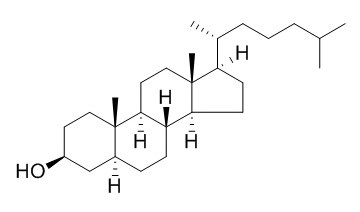Dihydrocholesterol
Dihydrocholesterol is a cholesterol derivative found in human feces, gallstones, eggs, and other biological matter. Dihydrocholesterol is equally effective in reducing plasma cholesterol as β-sitosterol at a low dose, which is mediated by inhibiting the cholesterol absorption and increasing the fecal sterol excretion.
Inquire / Order:
manager@chemfaces.com
Technical Inquiries:
service@chemfaces.com
Tel:
+86-27-84237783
Fax:
+86-27-84254680
Address:
1 Building, No. 83, CheCheng Rd., Wuhan Economic and Technological Development Zone, Wuhan, Hubei 430056, PRC
Providing storage is as stated on the product vial and the vial is kept tightly sealed, the product can be stored for up to
24 months(2-8C).
Wherever possible, you should prepare and use solutions on the same day. However, if you need to make up stock solutions in advance, we recommend that you store the solution as aliquots in tightly sealed vials at -20C. Generally, these will be useable for up to two weeks. Before use, and prior to opening the vial we recommend that you allow your product to equilibrate to room temperature for at least 1 hour.
Need more advice on solubility, usage and handling? Please email to: service@chemfaces.com
The packaging of the product may have turned upside down during transportation, resulting in the natural compounds adhering to the neck or cap of the vial. take the vial out of its packaging and gently shake to let the compounds fall to the bottom of the vial. for liquid products, centrifuge at 200-500 RPM to gather the liquid at the bottom of the vial. try to avoid loss or contamination during handling.
World J Microbiol Biotechnol.2024, 40(9):265.
Biol Pharm Bull.2018, 41(11):1645-1651
Pharmaceuticals (Basel).2020, 13(10):302.
Journal of Plant Growth Regulation2022, 10705-2.
Int Immunopharmacol. 2020, 83:106403.
Nutrients.2020, 12(3):595.
J Korean Soc Food Sci Nutr2023, 52(7): 750-757
Eur J Pharmacol.2022, 917:174744.
BMC Complement Altern Med.2018, 18(1):303
Environ Toxicol.2021, doi: 10.1002
Related and Featured Products
Br J Exp Pathol. 1979 Jun;60(3):231-8.
Dihydrocholesterol-induced gallstones in the rabbit: evidence that bile acids cause gallbladder epithelial injury.[Pubmed:
383127]
Rabbits fed a diet containing 0.75% Dihydrocholesterol for 7 days develop bile acid allodeoxycholic (ADCA) and deoxycholic acid (DCA) stones in the gallbladder.
METHODS AND RESULTS:
In this model, inflammatory changes in the gallbladder mucosa are often observed even before stones are formed. Within 3 days of the lithogenic diet, abnormalities of platelet function were detectable. Platelet aggregation upon addition of adenosine diphosphate (ADP) was impaired. At the same time the red cells became crenated and developed thorny spicules (echinocytes). This morphological changes was associated with intracellular dehydration and excessive loss of potassium. These changes coincided with a rise in serum ADCA and DCA and preceded a slow rise in serum cholesterol. In vitro incubation studies also suggested that the bile acids had probably caused membrane injury to the platelets and red cells.
CONCLUSIONS:
It is concluded that changes in the bile ADCA and DCA probably induce gallbladder epithelial injury in this model of experimental cholelithiasis.
Atherosclerosis. 2015 Sep;242(1):77-86.
Plasma cholesterol-lowering activity of dietary dihydrocholesterol in hypercholesterolemia hamsters.[Pubmed:
26184696 ]
Cholesterol analogs have been used to treat hypercholesterolemia. The present study was to examine the effect of Dihydrocholesterol (DC) on plasma total cholesterol (TC) compared with that of β-sitosterol (SI) in hamsters fed a high cholesterol diet.
METHODS AND RESULTS:
Forty-five male hamsters were randomly divided into 6 groups, fed either a non-cholesterol diet (NCD) or one of five high-cholesterol diets without addition of DC and SI (HCD) or with addition of 0.2% DC (DA), 0.3% DC (DB), 0.2% SI (SA), and 0.3% SI (SB), respectively, for 6 weeks. Results showed that DC added into diet at a dose of 0.2% could reduce plasma TC by 21%, comparable to that of SI (19%). At a higher dose of 0.3%, DC reduced plasma TC by 15%, less effective than SI (32%). Both DC and SI could increase the excretion of fecal sterols, however, DC was more effective in increasing the excretion of neutral sterols but it was less effective in increasing the excretion of acidic sterols compared with SI. Results on the incorporation of sterols in micellar solutions clearly demonstrated both DC and SI could displace the cholesterol from micelles with the former being more effective than the latter.
CONCLUSIONS:
DC was equally effective in reducing plasma cholesterol as SI at a low dose. Plasma TC-lowering activity of DC was mediated by inhibiting the cholesterol absorption and increasing the fecal sterol excretion.



